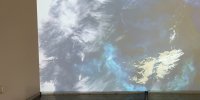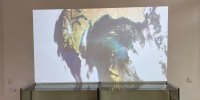Drifters - a mirror to us all
The artistic series “Drifters” serves as a reminder that today’s life on Earth has its origins in the depths of the seas. More than half of the world’s oxygen is produced by phytoplankton. Over 3 billion years ago, one of the first types of phytoplankton, cyanobacteria, began contributing to the oxygenation of Earth’s atmosphere through photosynthesis, which made the development of more complex life possible. Thus, phytoplankton also plays a key role in the global carbon cycle. Inspired by the complex and vital ecosystems of the oceans, “Drifters” also highlights the threats that phytoplankton face today. These include climate change, overfishing, and microplastic pollution, which endanger their health and the entire marine ecosystem.
“Drifters – a mirror to us all” is an installation in the Digital Forest that comprises a video projection, 3D prints of phytoplankton, oil shale, and thousands-of-years-old water from the UNESCO World Heritage site Grube Messel. This immersive artwork combines various elements to highlight the fragile interplay between marine and terrestrial life. In front of the video projection, there is a basin filled with the ancient water, which reflects the projection and creates a dynamic interaction with the words of the video’s voice-over, enhancing the sensory experience for visitors. The scientific research for this artwork was supported by the Alfred Wegener Institute, among others. The satellite images used were provided by the European Space Agency and NASA, adding a layer of authenticity and global perspective. Through this installation, “Drifters” not only emphasizes the crucial role of phytoplankton in the Earth’s ecosystem but also invites visitors to reflect on the interconnectedness of life and the urgent environmental issues that threaten these microscopic yet vital organisms.
CREDITS
Artists: Nina Bendzko
Format: Video projection, fish tanks, oil shale, 3D print
Year: 2024









